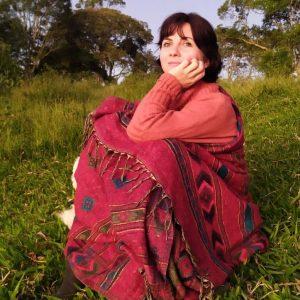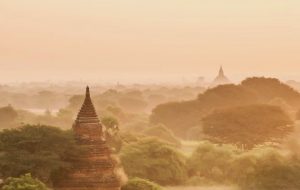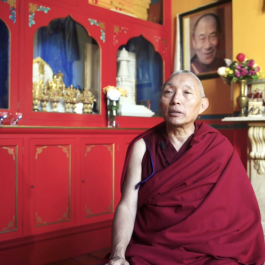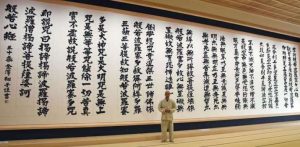When he looked at a flower with its five small and immaculate petals, his smile was luminous like the sunlight that bathed that same flower in warmth. He turned to his students in that English studio with the big glass windows (the light really was magical), and with the most genuine voice he asked us: “Isn’t it beautiful?” Beauty was revealed to him effortlessly and in a special manner, it moved him in such a way that he learned all his favorite poems by heart and recited them to us each morning, before starting class, with great elegance and inspiration. Early one morning, he actually made all of us sing a tribute made for Galileo Galilei:
Though my soul might set in darkness, it will rise in perfect light;
(Excerpt from “The Old Astronomer to His Pupil” by Sarah Williams [1837–69])
I have loved the stars too fondly to be fearful of the night.
Daniel, my teacher of sacred geometry, taught only what was in his heart—he was one of the few people I met in my life whose mind truly served his heart. His love of Beauty made him not only venerate and respect Nature, but also to deeply understand Her in a way that most of us have lost sight of. A lot of this had to do with perception, which all of the old-school masters of our ancient world held close. Daniel brought to vibrant life the spirits of Plato, Pythagoras, Kepler, Hermes Trismegistus, Rumi, and also the spirit of his own beloved teacher Keith Critchlow, who honored and brought to life the Philosophy of Nature. He was also reminded by what the poet Kathleen Raine had once said: it takes around four years to learn something at university and a lifetime to forget it. Because such knowledge—the kind that touches the heart—does not come from books or tests, but from silence and times of contemplation. If we are unable to contemplate our own existence without having to do something about it, by simply being in a place of stillness and silence, we can’t absorb the light of wisdom that is naturally available to us, just like someone inside a dark library reading about the benefits of sunlight can’t touch what he is looking for. The librarian’s words may all sound correct, but they are useless unless he has fallen in love and had a real experience and relationship with sunshine itself. His speech can be taught, printed, published, and sold, but this does not guarantee that it will bring what he promises, or transform him into the subject in which he eventually became an expert. It is a rare opportunity, therefore, to become close to teachers who have a mind (to be able to teach) that serves the wordless longing of the heart, and who are deeply moved and transformed by the love they feel for the subject they transfer to others.
Whenever I’m feeling lost in my creations, what I most like to recall is the light of that room full of drawings with its golden leaves and faded paint and little sculptures of wooden platonic solids and baskets made of interlaced hexagons. I remember that there I learned to deepen my ability to perceive beauty in all things and so to have a life more full of beauty and therefore grace. In the study of sacred geometry, we explore form to realize exactly what the Buddha said: “Form is emptiness; emptiness is form.” The same proportions which are in that five-petaled flower are also to be found in my own body and in the cells of my body, they all follow the golden ratio, a formula applied to me, to my body, and to the orbits of the planets. There is really no separation; it’s all the same. I wish I could remember this more often outside of that room that exhibited with all artistic human grace the infinite magical beauty and perfection of the universe.
Studying thangka art in India, I learned that deities depicted with a third eye in particular had that “power” of seeing beyond appearances. Because a tree, or a house, or a dog, or a person, or a nail in the wall are images that can penetrate our brain through light. One does not even have to touch them for them to become part of one’s inner life, to stimulate one’s feelings, emotions, and sometimes even one’s heartbeat and body temperature. But does this “thing” have the power to accelerate your heartbeat, like . . . a photo of your ex? (I guess that’s a good example . . .) Or is it the idea that you allow yourself to have about him or her what moves you internally? Once, the same image might have brought you peace, and after a while the same image can bring you sadness. Did the image change? How much are we building the meanings of all the images that invade our minds in our daily lives, especially with all what we see in the news, in social media, on the streets, and in malls, and on and on? And how much do we build these meanings in a conscious way, in an intelligent way?
Unfortunately, as most of us do not train our minds effectively. We are like leaves drifting helplessly on the breeze of a noisy, materialistic society that is convincing us in sweet, alluring ways that we do not have enough and that we need more. We need more security, more money, more love, and more beauty, and for that we need to work more and buy more. We have become quite sick—we all know that. We have lost the essence of beauty, the natural and always-available beauty. Today, the meaning of beauty is so much related to how it can serve “me,” my desires, and all my needs that are built on fear. With such a misguided view, the world suddenly looks wrong, imperfect, distorted, painful, and ugly. But maybe that is just how we ended up seeing the world. One ends up being the mountain or the valley, with a very simple, limited view of the whole vast landscape. Suffering usually happens when we are disconnected from the nature of reality, coupled with our projections of how we would like reality to be to serve our selfish, fearful needs. But this kind of relationship with reality can be retrained so that we can see things as they are, without bringing opinion into it, and then use reason and love to navigate whatever is presented.
Often attributed to Plato, the Irish romance novelist Margaret Wolfe Hungerford (1855–97) coined the modern idiom “beauty is in the eye of the beholder.” Do we hold our own eye? Who holds our vision, our perception? If you see that all things are wrong, that you are not beautiful, that your dog is smelly, that your car is old, that your house is expensive, that your mom doesn’t love you, that your friends are far, that your back is aching . . . I would kindly ask you to stop right there for a moment and just give it a chance. Let’s pause . . . close your eyes . . . take a few deeps breaths. Now open your eyes again and see how the light gently caresses all things around you, revealing many different shades and colors. Look at your hands and see how they create contrast against the wall. Your nails and hair are growing without any command from your mind; the flowers grow, rupturing through the earth; the bees build their hives in geometric perfection; the rain falls in drops. You grew from a tiny speck into this incredible engine called a human body. The Earth has orbited the Sun consistently for billions of years; Venus orbits the Sun every 224 days and spins on its axis every 243 days! Its day is longer than its year, plus she rotates in the opposite direction to all the other planets in our solar system! The path Venus follows in relation to the other planets, especially our Earth, creates a perfect pattern of beauty and balance. There is so much beauty around us, if we give it a chance and open up our third eye, the eye of true perception.

Create your own scenario. Notice all modest little things, without adding the need to feel happy or anything else; forgetting for now about constantly pursuing happiness. Just notice . . . and, slowly, maybe become curious, like a child with no other intention but to see. Come into this empty and spacious place of being. Space is always much more vast than all the contents of our mind. The tragedy is that nature holds no secrets and still we are unable recognize it without putting the “me,” the “I” in between. Somehow, we are told, something is missing and we do not know enough. We keep ourselves busy searching for meaning, when meaning is something alive waiting to be taken and experienced, like a lover. One cannot know what love is, one must experience it in its essence. No words can bring you to the power of transformation. Do not let intellect become your shiny armor, concealing the sight of your own skin and color—sometimes we have to be naked to experience the sunshine.
The American author Byron Katie has developed a series of questions that can help to open us up to the possibility of reconsidering the meaning we give to things, especially the painful meaning of difficult events. The first question she addresses to any idea one might come up with is: “Is this true?” And second: “This story you are telling yourself, are you certain that this is the ultimate truth?” And finally this leads to the two next questions: “What do you feel when you believe that is true?” and “Who are you without that thought?” You can try by yourself, working through these questions. Katie suggests writing out your answers in the most simple form.
I have found that those four questions, examined seriously and deeply, can really lead us to confront a clear mirror where we realize that most of the time we are sculpting others and things with beliefs that we don’t even want! Why, then, do we do it? Most of the time we do not see things as they are. We just see the meanings we give to them based on the unfolding of our unconscious actions. I know it is very difficult to change a belief, but we do have the option to rebuild our realities and even rebuild our past experiences. Between a negative meaning that brings one sorrow and a bright meaning that can only help us move further along our own path, which should you choose? This is when we become real artists, I would say—we create our realities! We are creative artists! This is the importance of using our creativity for our own benefit (because, seriously, we can also use it to create the nastiest obstacles for ourselves!)
Guru Rinpoche, the most important figure after the Buddha in Tibetan Buddhism, said: “Do not cut the root of phenomena, cut the root of the mind.” Nothing can be changed in the world if one does not change how one sees it. One can go into retreat in solitude in a cave in the Himalayas, and still carry with him all the people that one thinks one has left behind. Samsara is not the world, it is the mind! We cannot run away from it, we can only transform it with the training of awareness and the deep motivation of finding beauty in our lives, even amid death and chaos, because all these fatal circumstances are part of the balance of the universe. How dare we say that the universe is wrong. Don’t we think we should finally open our eyes and view it with reverence? We are not victims of the universe, we are part of it—literally part of it.

And as the British artist, author, sacred geometer, and professor of architecture Keith Critchlow always began and ended his classes, let us now make our prayer and shape our motivation. Let us master in more artistic ways our one mind and humbly accept beauty in ways we might not even comprehend. Let us make ourselves humble so that the vastness of the universe can fit within our minds and burst our hearts with its crazy and boundless love:
May we be guided by Truth
May Beauty be revealed to us.
And I wish that we may see with the eyes of contemplation, speak with the tongues of poets, dance with the hips of dancers, and travel with the hearts of pilgrims with our every step. It’s sacred and it’s right.
From star to star, from sun and spring and leaf,
And almost audible flowers whose sound is silence,
And in the common meadows, springs the seed of life.Now the lilies open, and the rose
Released by summer from the harmless graves
That, centuries deep, are in the air we breathe,
And in our earth, and in our daily bread.External and innate dimensions hold
(“Seed” by Kathleen Raine [1908–2003])
The living forms, but not the force of life;
For that interior and holy tree
That in the heart of hearts outlives the world
Spreads earthly shade into eternity.
See more
Related features from BDG
Thinking Is a Skill. But Someone Else Figured it Out Before You
Ecstasy: The Path of Joy
The Wild, Wise Feminine
















